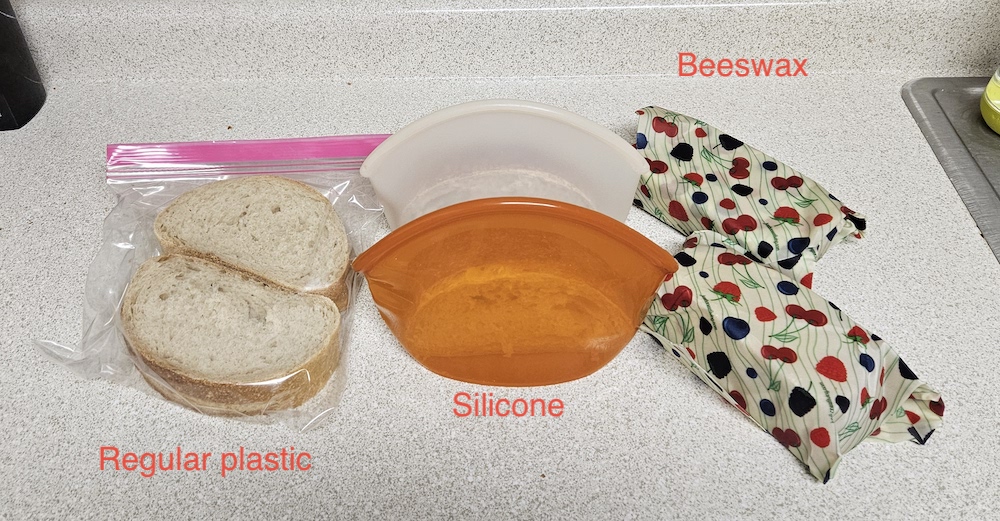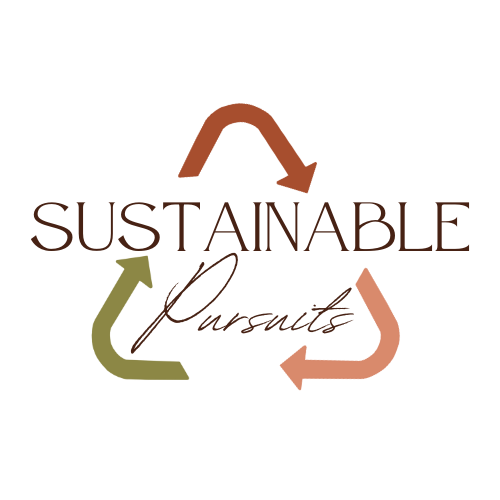This month I’m going to do things a little differently. Instead of focusing on making foods to be plastic-free, I’m going to take a look at different options for food storage. Lately, I’ve been wondering about the alternatives to plastic wrap. Over the past couple of years, I’ve been using different things instead of the cling wrap like beeswax cloth and fabric bowl covers. But now I want to do a proper comparison.
By comparing the alternatives, I’ll be able to build better habits around my food storage. I’m also very curious about the best use for each of the alternatives and how to use them.
What are the alternatives to plastic wrap?
The alternatives I frequently come across are the beeswax cloth and silicone pouches. Beeswax cloth is a traditional form of food wrapping that is essentially a cotton cloth “infused” with beeswax. It is pliable and self-adhesive, and the beeswax provides a breathable protective barrier for the food.
Silicone bags/pouches are used as plastic alternatives because silicone is very versatile, flexible, and provides an air-tight barrier with the additional benefit of being heat resistant. There’s a lot to cover about silicone, so I’ll focus more on it and the beeswax wrap in another post.
Figuring out what foods to test
To test the alternatives, I had to think about when I usually use plastic cling wrap and bags. In the past, I used cling wrap to cover leftovers in the fridge and save half-cut veggies. Plus using the cling wrap to prepare certain foods and making to-go portions. However, now that I use cloth bowl covers, silicone lids, and veggie savers (more on these later), I rarely need cling wrap for leftovers.
So where am I still using the plastic wrap and baggies?… The freezer.
Aside from the block cheeses and salads, most of my single-use plastics are in the freezer. (Using block cheese still helps to reduce my overall plastic usage even though it comes in plastic wrap). And the freezer is only getting fuller now that I’m baking more. I’ve found that it works better to make bigger batches of food in one go and then freeze them for later.
Hence the importance of figuring out what food storage alternatives work well in the freezer.
How I’m experimenting with these alternatives to plastic wrap.
- This week, I made 3 batches of chickpea crepes and portioned them in a plastic bag, a silicone pouch, and wrapped them in beeswax cloth. The individual crepes are separated with parchment paper and put into the freezer.
- I also bought bread (using my bread bag) and portioned them out in the same way as the crepes – plastic bag, silicone pouch, and beeswax wrap. Then put them in the freezer as well.
- In about 2 weeks I will pull a portion of the bread and crepes out of the freezer and see how well they stored in their respective containers.
- Then in another 2 weeks, I’ll pull the remainder out of the freezer and see how they fared. I’ll be looking for signs of freezer burn and how well the container stayed sealed.

I know, there are many other foods I could be testing, both in the freezer and fridge. But these are the foods that I’m personally needing to freeze right now. After this month, I’ll try to include a freezer/fridge storage section in the challenge updates that involve food.
On that note, I should give a quick update on the deli meats. I’ve been storing the meat in the freezer by rewrapping it in the butcher paper and putting it in an air-tight container. So far that’s been working pretty well. Especially since I only store the meat for about a month. Butcher paper typically has a plastic lining, so this way I’m getting an additional use out of it.
Also testing a food prep method
The other test will be making rice balls. I went through a period when I made rice balls all the time. The process I used required plastic cling wrap for shaping the rice balls and storing them. Not only will rice balls be a good food to test different plastic wrap alternatives they’ll also make a nice break from sandwiches.
What will be covered this month?
- The history of plastic wrap and more info about the alternatives.
- Recommendations for how to use the plastic wrap alternatives.
- The different ways you can find beeswax cloth and silicone food containers.
- How well the alternatives to plastic wrap are working. At least with the foods I’m testing.
If you are looking for more information on how to store foods like bread, I recommend reading this article by King Arther Flour, they even mention a method that doesn’t use plastic. Also, here’s some quick tips from Plastic Free July about plastic wrap alternatives.
Let me know which plastic wrap alternative you personally prefer in the comments below!

